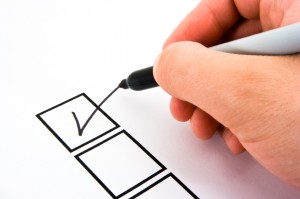Think your blog can be better than it is? Of course it can. Lucky for you, our free tools make every blog more awesome.
Have you ever cringed while reading a post? Have you ever cringed while reading a post YOU wrote?
There are so many things to consider before you hit “Publish” and your post goes live. The following blogging checklist should prevent any cringing going forth in your blogging adventures.
1. Title optimization
Let’s start right at the top. Your title is important for two reasons: Firstly, it grabs your audience attention and secondly, before your title can grab any attention, it has to be search-engine friendly and include main keywords that people search for.
2. Spelling and grammar
I don’t know about you but I have been mortified in the past when I noticed a spelling or grammatical error in my posts. The truth is although the error every now and then is forgivable, your audience will not be amused if it becomes a pattern. Moreover, that’s why spell check was invented folks.
3. Content optimization
Just as your title should include main keywords, so should your content. There are many ways to get a feel for what people are searching for regarding your subject matter including using WordPress themes that will conduct SEO for you, using Google keywords or even just using Google to search your subject matter to see the kinds of things that come up
4. Heading tags
As the best bloggers will tell you, whether your content calls for lists or not, headline tags are very important for visually separating your content so that the reader has an easier time following your post. Your posts may not always call for it but as much as you can, use headline tags
5. Interlinking
This is when you include links from posts that you have written earlier. Many times as a blogger, you have a specific niche and as well as driving more traffic to your site, interlinking is a good way to show that you have become an expert in your niche.
6. One idea per paragraph
Blogging is a science and an art because while there are many good story tellers, some fail to become good bloggers. One of the key ingredients to being a good blogger is to make sure that one idea is kept to one paragraph because though you are telling a story, you are not writing a novel. Your audience wants you to get to the main points and to stay focused.
7. Meta description
This is another check for the search engines. If you’ve ever seen the one or two sentences that pull up about a story, this is what is known as the meta description. It gives your audience a little preview of what to expect from the post and when done right, the meta description will draw new readers.
8. Image formatting
When I first started blogging, image formatting used to frustrate me so much. Be sure to have a process that you like and that suits you. Be sure to check out different WordPress plugins and settings that can also help you get your image formatting done right so that is aligns the way you want it to with content.
9. “ALT” tag
This is hidden trick that veteran bloggers know too well. When you upload an image, always include the description of the image in itself in the “ALT” space which helps search engines pull up your post as well.
10. One language format
If you happen to be one of those lucky people who was trained in British grammar but living in the US of A or vice versa, be sure to stick to one language format. It gets confusing for your readers and additionally can also give any specific reader the notion that you have spelled words incorrectly.
11. External links
We’ve all been rookie bloggers at some point and rookie bloggers tend to make the mistake of not checking their external links (or any of their links) to make sure they open in a new window. While, linking shows that you’ve done research and therefore give you credibility, you want the reader to stay on your site, so don’t drive them away from the page unless it’s in a new window.
12. Original sources
Having authentic sources is important for any blogger but especially for business bloggers or sponsored posts that you may publish. Don’t just include statistics or data from any Tom, Dick and Harry. If you can get the site with the original content, say who and where and why. The more credible your source is, the more credible you are.
13. Sources credit
As a follow up from looking for original source content, it’s not enough to simply give the original author or site a shout out, link back to them too. If you can link to a specific article or page on the site, even better.
14. Keyword and links spam
As you may have noticed, I love SEO and links – interlinking and external linking, especially when it’s done right. However, one thing to be very careful of is to not be a keyword and link spammer. I use the word, “spammer” because for all intents and purposes, if every other sentence in your post has a link or an obvious phrase keyword, your audience will know and they will not be impressed.
15. URL permalink
Like many bloggers, in my beginner blogging days, I used the default permalink that was in WordPress because I didn’t know the difference a permalink makes to the eye of the beholder. Including your blog categories or general themes is definitely call for. You may also customize the permalink to suit you needs especially if you’re a blogger with several categories.
16. Length
As I said earlier, you’re a blogger and thus you are also a story teller. You are not, however, a novelist. While length may vary depending on your blog style, most people do not want to read long posts so keep it within reason. If you can break your post into a two or three part series, do it. If a paragraph is unnecessary, cut it out.
17. Video and audio
This can be tricky one so always check to see if the link on your video or audio is working on your post and as these usually give your post an edge, readers will be disappointed if they don’t work. I know Youtube makes it really easy to share videos on your post by giving you the buttons on actual video that you can link to on the specific post.
18. Publishing schedule
Like many people I know, blogging may be a hobby or it may be side hustle but between the 1001 things we have to do, the last thing you want is to have your post go up on a day or time you didn’t intend. While many people have different ideas on the best day and time to publish a post, always make sure you schedule correctly especially if your post happens to related to something in current events.
19. Call to action
For me, a call to action is the testament of a good blogger. He or she drives their audience to comment by asking for their feedback regarding the specific content. No matter what kind of posts you write, you can always ask for your audience to share their opinions.
20. Preview the layout
Promise me, that no matter how tired you are, no matter how many times you’ve formatted and checked for spelling errors and made sure that the post is scheduled on the correct day, that you will NEVER ever leave your draft without first previewing.
I hope this list helps you regardless of whether you’re a beginner, intermediate or professional blogger. Are there any other things you check off your list before you hit “publish”? Let us know in the comments.

